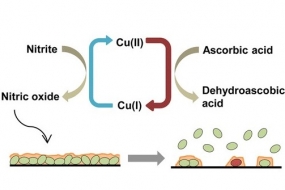The presence of surviving microbes in the water distribution system lead to the biofilms formation, which will reduce the efficacy of disinfection, increase pipe corrosion and adversely affect pipe hydraulic. The growth of microbial in biofilms will reduce water quality, cause taste and odor problems and proliferation of macroinvertebrates. Many attempts have been done to mitigate the formation of these biofilm, such as reduction of organic matter, improved disinfection and implementation of corrosion control in piping or combination of those methods.
The use of nitric oxide generated from the catalytic reaction between a copper(II) complex embedded in a PVC matrix with nitrite (source of nitric oxide) and ascorbic acid (reducing agent) to control the formation and dispersion of nitrifying bacteria biofilms was reported in this paper. When copper complex was used, higher and prolonged nitric oxide generation can be achieved as compared to nitrite and ascorbic acid solutions alone. The enhanced nitric oxide generation subsequently caused higher biofilm suppression compared to the use of nitrite-ascorbic acid alone. Moreover, when catalytically generated nitric oxide was used on a pre-formed biofilm, the system can effectively disperse/remove the biofilm. This study highlight the potential of catalytic generation of nitric oxide for the long-term suppression and removal of biofilm.
Read more: ACS Applied Material Interfaces (DOI: 10.1021/acsami.5b07971)
TOC of ACS Applied Materials Interface DOI: 10.1021/acsami.5b07971
